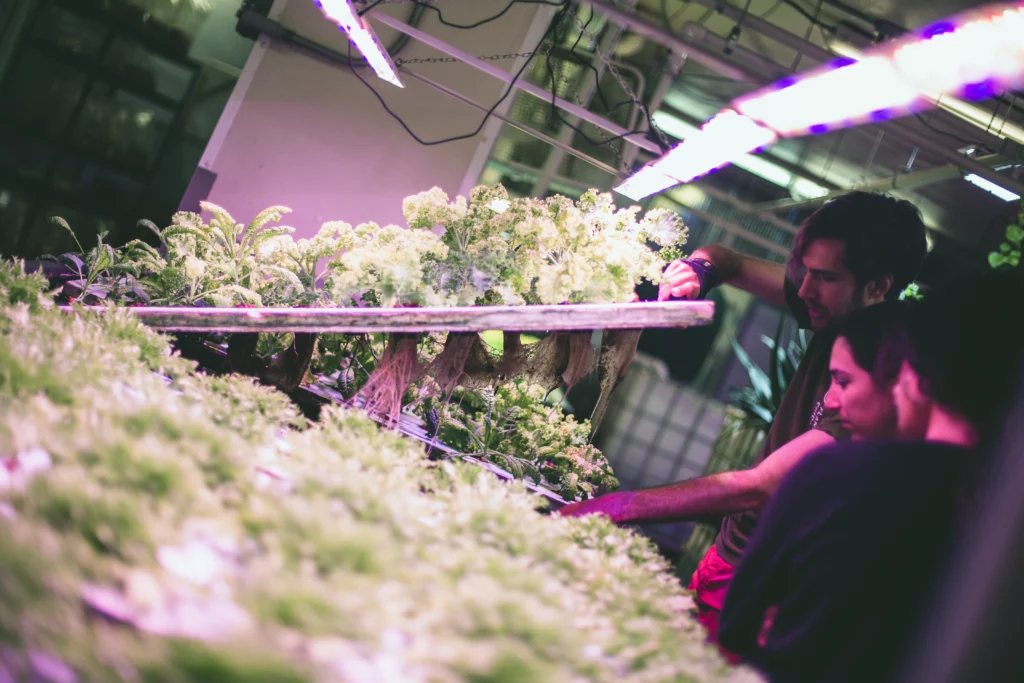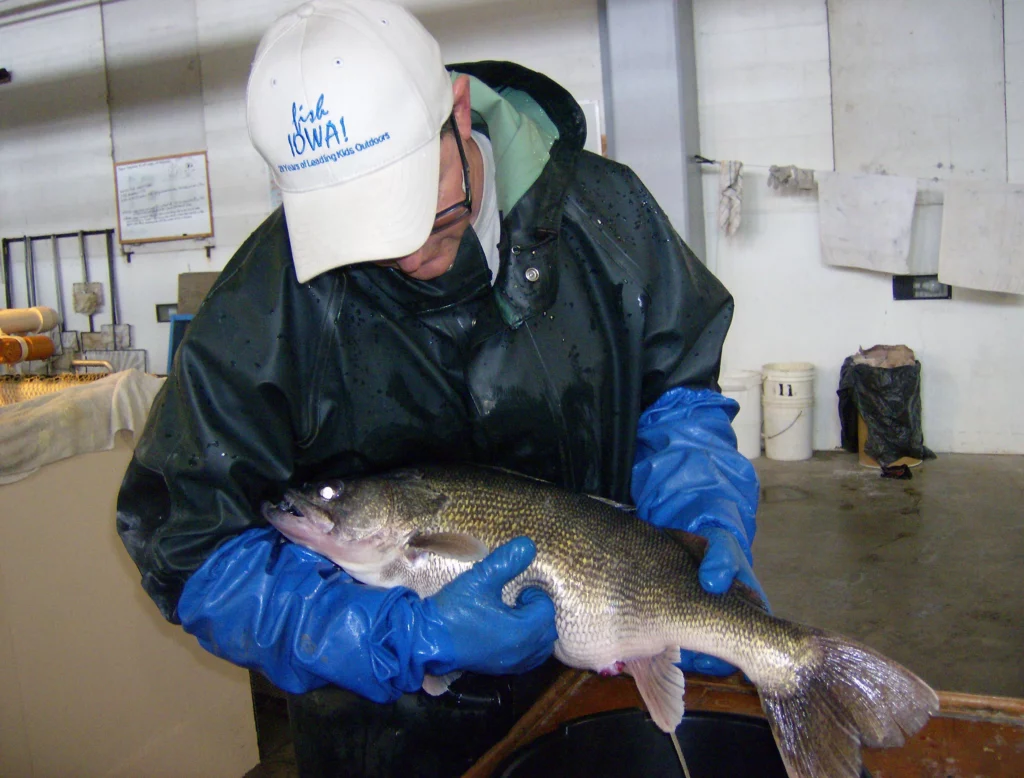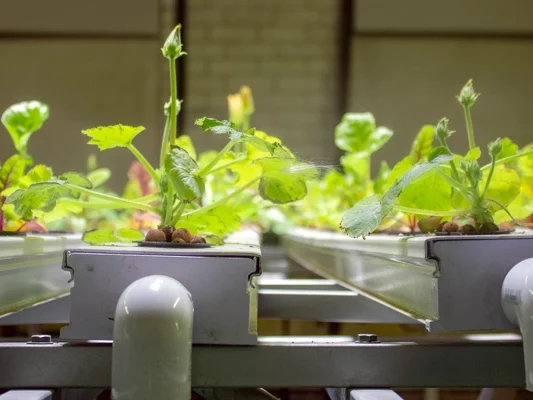Despite the recent drought, the Midwest is producing fresh produce and fish—indoors.

2023 was a rough year for Iowa. According to an Iowa Department of Natural Resources (DNR) water summary update, the state experienced its third consecutive year in a drought. As the world’s leading producer of corn, this has major implications for agriculture—but the drought doesn’t just affect crops. Iowa’s lakes and rivers are also threatened, and with it, the state’s aquaculture.
Home to eight fish hatcheries, the state’s DNR stocks more than 130 million fish each year into Iowa waters. For facilities like the one 90 miles southeast of Des Moines at Rathbun Lake, the water comes straight from the lake to supply the hatchery’s operations.
“We were getting a little concerned about the drought,” says Chris Clouse, hatchery manager at Rathbun Lake. “[The lake’s water level] was the lowest I’d seen it in 25 years last summer.”

Completed in 1969, the construction of a dam to create the lake was done by the U.S. Army Corps of Engineers. In 1971, President Nixon visited Iowa to dedicate the dam. Back then, it was much more common to build man-made reservoirs. Right now, the Rathbun hatchery produces millions of walleye fry each year. In fact, Clouse says his hatchery produces more pounds of walleye than anywhere else in the world.
But Clouse says the days are numbered for hatcheries that run on surface water, especially from man-made lakes like Rathbun. With it, a new practice for growing fish is taking shape.
“The value of the farmland is so great that it’s difficult to build a lake, so I think there’s a good opportunity for recirculating aquaculture,” Clouse says.
A giant warehouse aquarium
Picture a hobby aquarium: a tank with fish, a water source, and a filtration system. Recirculating aquaculture systems (RAS) are basically just that. The same principles apply, but the difference is the scale at which this exists. RAS have the potential to be set up almost anywhere, like in 20,000 square feet of an old shopping mall, or even in the middle of a big city.
“You could put [an RAS] in downtown Des Moines in a warehouse,” Clouse says. “And you could start producing fish, as long as you had the money to pay for the [water] running and the electricity to keep the place going. You can control temperature throughout the year, so you can grow fish all year long.”
It’s a major opportunity in a state that’s facing climate pressures from all sides. Between harsh winters, hot, dry summers, and the rising threat of invasive species like zebra mussels that outcompete native species for food, the idea of an indoor hatchery system, like RAS, is appealing.
And this comes at a time when fish is appearing on menus more frequently. According to the USDA, growth in fresh and frozen seafood consumption per capita climbed from just over 60% in 1990 to nearly 80% in 2021. This trend shows no signs of stopping. In a 2023 report by Circana, 54% of surveyed Americans say they eat more seafood at home than they did two years ago. What’s striking is that consumers also said they want their seafood to be from the U.S.—not imported.
That’s where an RAS comes in. Fish can be grown almost anywhere, so it’s less reliant on importing from other countries, or even other regions in the U.S.
Take Midland Co. seafood for example. They’re just off of I-35 in Ames, Iowa. Originally started by a couple of Iowa State grads in 2018, the company produces shrimp. In Iowa. And they’re not the only company to do this. NaturalShrimp, out of Texas, acquired a former aquaculture facility in Webster City, Iowa, in 2021.
“I think that’s something you’ll see expanding within not only Iowa, but every state will probably be raising fish more that way, which is a little bit less natural, but is a little bit more efficient,” Clouse says.
The efficiency of aquaculture doesn’t stop here. It has the potential to help develop closed loop systems, like aquaponics. By reusing waste water from aquaculture as natural fertilizer for plants, aquaponics creates a continuous, recirculating system. And similar to RAS, this isn’t constrained to farms. It can happen anywhere. Even in a 100-year-old firehouse in Chicago.
Growing fish and lettuce simultaneously—in Chicago
Plant Chicago, a nonprofit just a few miles south of downtown Chicago, works to make communities more sustainable. They come up with innovative ways to reduce waste and even host events like food scrap exchanges. But they’re also home to one of Chicago’s only aquaponics systems.

“Aquaponics, for us, originally started, in part because nobody else was doing it,” says Eric Weber, director of operations at Plant Chicago. “It was originally intended for us to start farming aquaponically and grow to where it could spin off from the nonprofit.”
While the aquaponics portion never did become an independent for-profit company, Plant Chicago still grows all kinds of plants aquaponically—lettuce, kale, spinach, fresh flowers, and more. And in addition to harvesting fresh plants, there’s the added benefit of raising fish for consumption.
“We started out years ago using tilapia,” Weber says. “Those are the de facto for most aquaponic growers.”
Weber says tilapia is a top choice because of how quickly they grow. Farmers don’t have to feed them for as long, and they can be harvested in as few as 8-10 months. While Plant Chicago primarily educates community members and students about the benefits of aquaponics, there are still very few places that actually employ this practice for-profit. But every once in a while, another will pop up, just like with aquaculture farms in Iowa.
“The technology has been out there for a while and it’s just getting more and more utilized,” Clouse says.
Utilizing technology is a major opportunity to sustain the increasing global population through both aquaculture and aquaponics—in spite of climate change.
